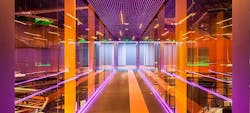In this week’s edition of Voices of the Industry, William Dougherty, Senior Vice President and Chief Technology Officer at RagingWire Data Centers addresses key questions about data center design and operations.
William Dougherty, Sr. VP and CTO, RagingWire Data Centers
What, exactly, is a data center? It seems a simple question, but the answer has become increasingly elusive. In its simplest form, a data center is a physical space that houses computers. But that answer could apply to your closet.
So, what is a data center?
A data center is more than just a building. Providing secure space, efficient and reliable cooling, highly available power, and diverse carrier connectivity are the minimum table stakes. What separates a good data center from a best-in-class provider is the ability to understand that these table stakes are no longer enough.
Now, what makes a great data center?
The best data centers are designed from the ground up with a focus on the customer experience. These facilities must be optimized for technology and equipment, but also take into account the experience of the staff who will work in the building, as well as the potential customers seeking to evaluate the data center.
Observation Room Overlooking the Mechanical and Electrical Infrastructure at RagingWire’s CA3 Facility
Too often, the experience of prospects is treated as an afterthought, rather than a priority that guides the design of the data center. A potential customer should be able to tour every aspect of the building without ever entering a secure space. This balance must be integrated into the planning and design of a data center.
In addition to standard customer facilities like conference rooms and drop-in workspaces, today’s data center should provide additional amenities such as game rooms, client fitness rooms, lockers and showers, or even a rock climbing wall. The idea is to create an environment for IT professionals that allows them to be productive, comfortable, and efficient.
Today’s data center should provide customer amenities such as game rooms, client fitness rooms, lockers and showers.
Most customers maintain long-term relationships with their data center provider. This means a data center must be designed so that computing environments can scale within the facility or as part of a campus environment. This includes things like an ability to increase the power density to a specific rack as well as fiber connections throughout the campus. In the end, you need the ability to do long-term capacity planning and be confident that you will not outgrow the capabilities of the facility.
In today’s world, where our lives have become intertwined with our technology, the data center has become much more than just a building. It is a home for your mission critical computing infrastructure. It is a place where your IT professionals go to work. It is a platform for your business to grow. In this new world, the data center must be the most comfortable, secure, scalable, flexible, efficient, connected, and reliable home that empowers you to be successful.
At RagingWire we pioneered the concept of the ‘cut-away data center.’ It allows a potential customer to tour every aspect of the building – switch gear, batteries, chiller plants and white space – without ever entering a secure space. This protects the prospective client and ensures that existing clients are never at risk.
– William Dougherty
William Dougherty is the CTO of RagingWire Data Centers. He holds a Master of Science in Information Technology from Capella University, and a Bachelor of Science in Business Administration from Pepperdine University.


